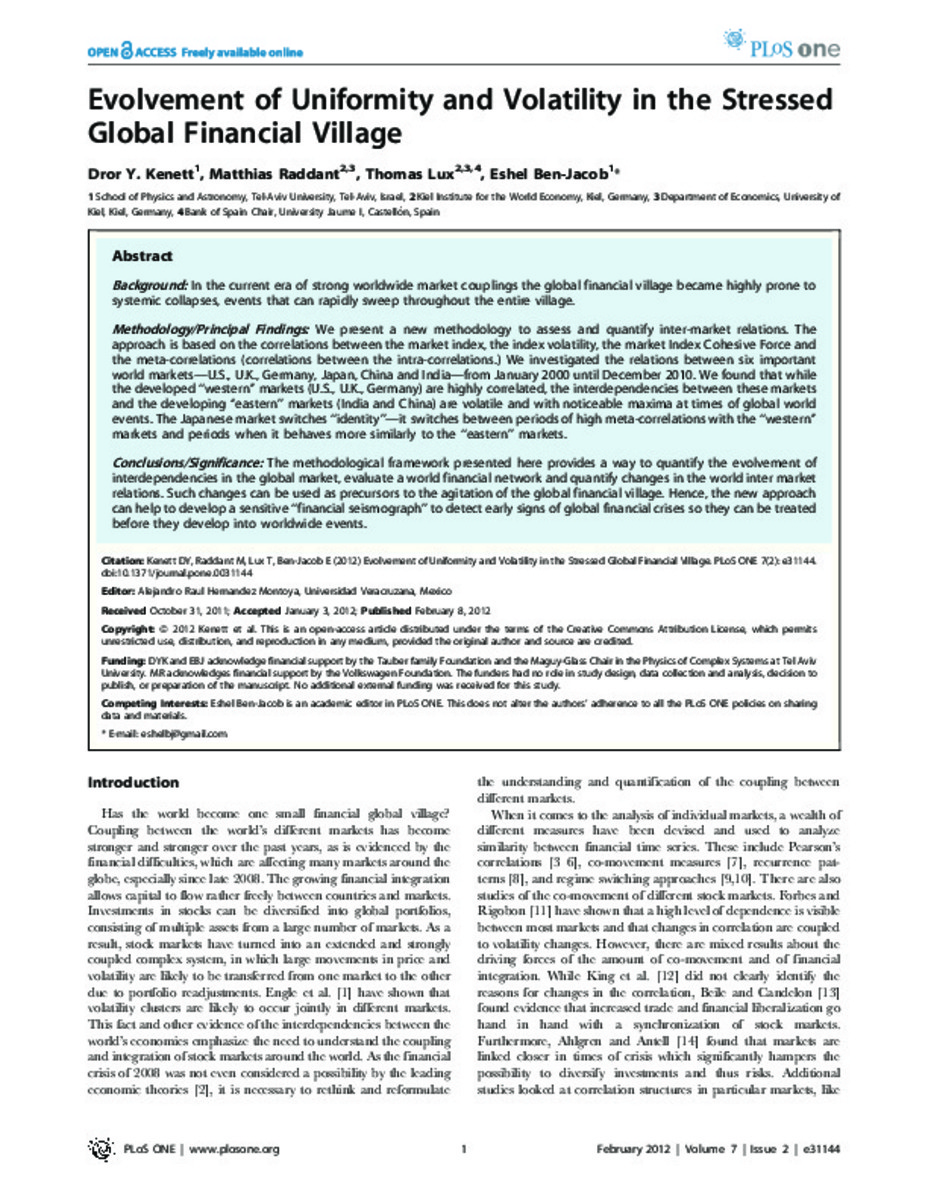Mostrar el registro sencillo del ítem
Evolvement of uniformity and volatility in the stressed global financial village
| dc.contributor.author | Kenett, Dror Y. | |
| dc.contributor.author | Raddant, Matthias | |
| dc.contributor.author | Lux, Thomas | |
| dc.contributor.author | Ben-Jacob, Eshel | |
| dc.date.accessioned | 2013-05-24T17:30:26Z | |
| dc.date.available | 2013-05-24T17:30:26Z | |
| dc.date.issued | 2012 | |
| dc.identifier.issn | 1932-6203 | |
| dc.identifier.issn | 1932-6203 | |
| dc.identifier.uri | http://hdl.handle.net/10234/64553 | |
| dc.description.abstract | Background: In the current era of strong worldwide market couplings the global financial village became highly prone to systemic collapses, events that can rapidly sweep throughout the entire village. Methodology/Principal Findings: We present a new methodology to assess and quantify inter-market relations. The approach is based on the correlations between the market index, the index volatility, the market Index Cohesive Force and the meta-correlations (correlations between the intra-correlations.) We investigated the relations between six important world markets—U.S., U.K., Germany, Japan, China and India—from January 2000 until December 2010. We found that while the developed ‘‘western’’ markets (U.S., U.K., Germany) are highly correlated, the interdependencies between these markets and the developing ‘‘eastern’’ markets (India and China) are volatile and with noticeable maxima at times of global world events. The Japanese market switches ‘‘identity’’—it switches between periods of high meta-correlations with the ‘‘western’’ markets and periods when it behaves more similarly to the ‘‘eastern’’ markets. Conclusions/Significance: The methodological framework presented here provides a way to quantify the evolvement of interdependencies in the global market, evaluate a world financial network and quantify changes in the world inter market relations. Such changes can be used as precursors to the agitation of the global financial village. Hence, the new approach can help to develop a sensitive ‘‘financial seismograph’’ to detect early signs of global financial crises so they can be treated before they develop into worldwide events | ca_CA |
| dc.format.extent | 8 p. | ca_CA |
| dc.format.mimetype | application/pdf | ca_CA |
| dc.language.iso | eng | ca_CA |
| dc.publisher | Public Library of Science | ca_CA |
| dc.relation.isPartOf | PLoS ONE, February, Volume 7, Issue 2, e31144 | ca_CA |
| dc.rights | © 2012 Kenett et al. This is an open-access article distributed under the terms of the Creative Commons Attribution License, which permits unrestricted use, distribution, and reproduction in any medium, provided the original author and source are credited. | ca_CA |
| dc.rights.uri | http://creativecommons.org/licenses/by-sa/4.0/ | |
| dc.subject.ddc | 330 | |
| dc.title | Evolvement of uniformity and volatility in the stressed global financial village | ca_CA |
| dc.type | info:eu-repo/semantics/article | ca_CA |
| dc.identifier.doi | http://dx.doi.org/10.1371/journal.pone.0031144 | |
| dc.rights.accessRights | info:eu-repo/semantics/openAccess | ca_CA |
| dc.relation.publisherVersion | http://www.plosone.org/article/fetchObject.action?uri=info%3Adoi%2F10.1371%2Fjournal.pone.0031144&representation=PDF | ca_CA |
| dc.type.version | info:eu-repo/semantics/publishedVersion |
Ficheros en el ítem
Este ítem aparece en la(s) siguiente(s) colección(ones)
-
ECO_Articles [692]
Excepto si se señala otra cosa, la licencia del ítem se describe como: © 2012 Kenett et al. This is an open-access article distributed under the terms of the Creative Commons Attribution License, which permits
unrestricted use, distribution, and reproduction in any medium, provided the original author and source are credited.








